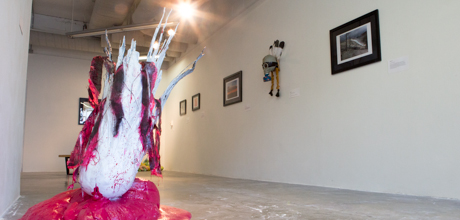By Julyssa Lopez
Research science and artistic expression may seem an unlikely pairing, but the combination made perfect sense to doctoral candidates Kes Schroer and Serena Bianchi of George Washington’s Center for the Advanced Study of Hominid Paleobiology (CASHP).
The duo approached sophomore Roxanne Goldberg, an art history and journalism major, last September, hoping to create an exhibit using photographs taken by CASHP scientists and researchers. The pictures captured moments in research sites all over the globe: primates in Tanzania, villages in Kenya and landscapes in Yellowstone Park.
After studying each image, Ms. Goldberg realized these captivating photos could serve as a springboard for even more creativity. The three students decided to find artists who could interpret the photographs and then showcase their work alongside the images.
This collision of art and science culminated into Gallery 102’s student-curated show, “art + evolution,” which opened Tuesday. A reception will be held Thursday at 6 p.m. Each piece in the exhibit is tethered to the theme of evolution—CASHP’s main area of focus.
“In this show, we wanted to explore the origins of creativity. How is creativity part of our evolution? How is it a part of adaptation? Also, how does creativity continue to play a role in how we perceive and present evolution?” Ms. Schroer said.
Ms. Goldberg spent weeks hunting for relevant work to showcase. She sent the research photographs to local artists and students and waited for inspiration to strike. The responses came steadily, until 11 artists had promised to lend existing pieces or create projects from scratch.
The final display is dynamic and rich with diverse interpretations, featuring everything from sculptures to video installations that complement the photographs. Some pairings are direct and sharply literal, while others are quieter abstractions.
Viewers might first gravitate toward DC-based sculptor David Mordini’s gory “The Fingers,” five gnarled appendage-shaped fiber sculptures protruding from the gallery’s central wall. The piece is partnered with “Gizmo,” a photograph of an eponymous chimp stroking a branch with his long fingers. The photo was taken by Carson Murray, assistant professor of anthropology, during Tanzania’s Gombe Stream Chimpanzee Research Project. “The Fingers” exaggerates the monkey’s delicate hand, amplifying the human-like features of his small fingers to an alarmingly large scale.
Jessica Beels, a designer and sculptor from D.C., took a much more explicit approach with her piece “Point of Impact.” Ms. Beels set to work immediately after seeing CASHP doctoral candidate Andrew Zipkin’s arrowhead photograph, “Obsidian Microlithic Tool: Surface Discovery at Olorgesailie, Kenya.” She examined the areas where the arrowhead was carved most deeply and replicated her own version of the ancient tool with flax and paper made from an abaca plant.
Three ceramic drums adorn a far corner of the gallery. A simple sign on the wall provides instructions: Please Play. Senior Gabe Bellowe, one of three GW students whose work is featured in the exhibit, created the instruments to invite social interaction while also evoking the African cultures depicted in many of the photographs.
The importance of including social elements, like a drum circle, in a show about evolution was discussed in the lecture “Symbols, Evolution and Art,” given by Alison Brooks, an anthropology professor, on Monday.
“She talked about the benefit of having symbols and increased communication in ancient societies,” Ms. Schroer said. “It all comes back to making social connections and establishing group identity.”
Ms. Goldberg and Ms. Schroer agreed artists in the exhibit have captured the creative and scientific side of expressing thoughts about evolution.
“This is right at the heart of our program,” Ms. Schroer said. “We want to reach as many people as we can and explain why human evolution is important and why it’s exciting.”


